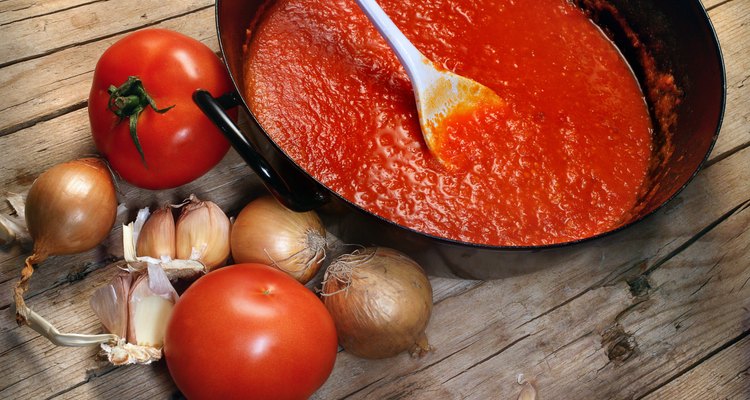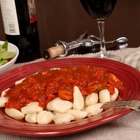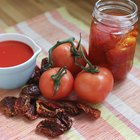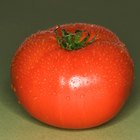
katarina drpic/iStock/Getty Images
Cooking is chemistry and foods are collections of compounds, each of which possess a pH -- a concentration of hydrogen molecules expressed in a number from 0 to 14. Acids have a pH below 7.0 -- the neutral point. Although digestion begins with acid in our stomachs, a sauce with too much acid overwhelms the taste of whatever it touches and slows digestion, perhaps resulting in heartburn. Fortunately, there are ways to reduce the acid in the sauces that we put on foods.
Start over with small quantity sauces, such as a hollandaise, or discard some of it and use the rest as a base for new sauce. Do not add salt or acids such as vinegar or lemon juice with new ingredients. Larger quantity sauces, such as spaghetti sauce, retain their character with additions.
Add low-acid whole tomatoes to sauce made with tomato sauce, an ingredient with a pH as much as one point below whole tomatoes. Use Roma or other tomatoes traditionally used for sauces. Grow “sweet” varieties such as Wisconsin 55 or heritage varieties for homemade sauces.
Raise the sauce’s pH by adding vegetables like mushrooms and onions as part of the sauce. Float a few potatoes in the sauce while it cooks and remove them when the sauce is finished cooking.
Add sugar or vegetables such as carrots that contain sugar. Although sugar’s pH is 5.0 to 6.0, its major effect is to soften the sharp taste of tomatoes, which have a pH averaging 4.2 to 4.9.
Add dairy such as cheese or milk. Butter, milk, cream and egg whites have pHs that range from 6 to 8. Although you might not want to add cream to tomato sauce, a few pads of butter or shredded cheese would blend in.
Related Articles

How to Make Delicious, Homemade ...

How to Use Pectin to Thicken Sauces
How Many Calories Are in Peanut Sauce?

How Can I Counteract the Sourness of a ...

How to Use Ricotta Cheese for Cream ...

How to Freeze Yogurt Sauce

How to Tone Down Spiciness in BBQ Sauce

How to Cook Strawberries

How to Thicken Sauce With Powdered ...

How to Make a Real, Authentic Ponzu ...

How to Freeze Marinara Sauces

Can I Make Caramel Sauce by Melting ...

What Is Browning Sauce for Steaks?

How to Substitute Tomato Ingredients in ...

How to Blanch, Peel, & Freeze Whole ...

How to Make a Fruit Reduction

How to Make Cayenne Pepper Sauce

How to Make Fresh Clam Sauce

How to Make Eggs Benedict With ...

How to Degrease Sauce
References
Tips
- Warm milk before gradually adding hot, acidic sauce to it to avoid curdling the milk.
- Mix dressings for salads separately from vegetable preparation so they can be corrected before adding to the vegetables. Remember that potatoes absorb salt and vinegar, so dressing needs to be piquant.
Warnings
- Fussing with delicate sauces may create a new taste sensation or a mess with ruined texture or taste.
Writer Bio
An avid perennial gardener and old house owner, Laura Reynolds has had careers in teaching and juvenile justice. A retired municipal judgem Reynolds holds a degree in communications from Northern Illinois University. Her six children and stepchildren served as subjects of editorials during her tenure as a local newspaper editor.
Photo Credits
katarina drpic/iStock/Getty Images